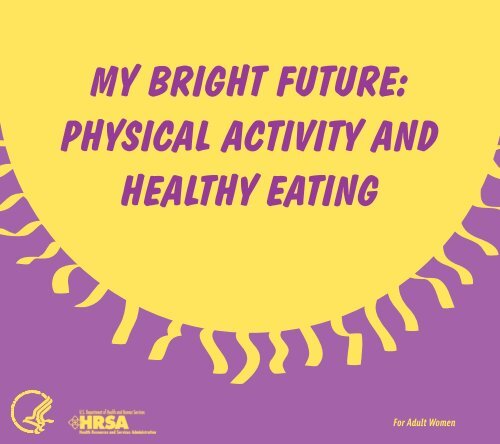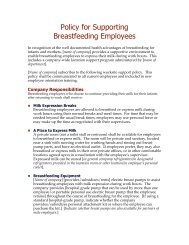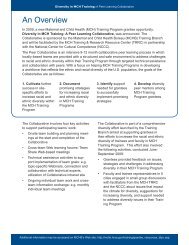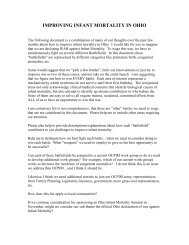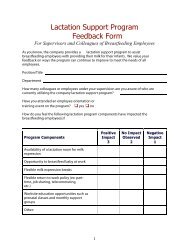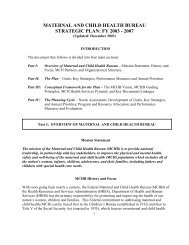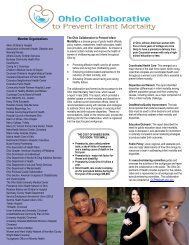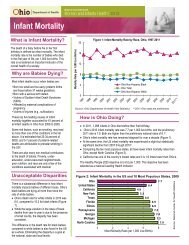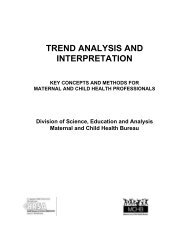My Bright Future: Physical Activity and Healthy Eating Tools ... - HRSA
My Bright Future: Physical Activity and Healthy Eating Tools ... - HRSA
My Bright Future: Physical Activity and Healthy Eating Tools ... - HRSA
You also want an ePaper? Increase the reach of your titles
YUMPU automatically turns print PDFs into web optimized ePapers that Google loves.
MY BRIGHT FUTURE:<br />
PHYSICAL ACTIVITY AND<br />
HEALTHY EATING<br />
For Adult Women
This booklet will help you learn more about the importance of physical activity <strong>and</strong> healthy eating in your<br />
daily life. It will also help you talk with your health care provider about these topics <strong>and</strong> set healthy goals.<br />
Getting Started: Questions to answer on your own <strong>and</strong> talk about with your health care provider. . . . . . . . . . . . . 3<br />
Talking With <strong>My</strong> Health Care Provider: Examples of questions to ask your health care provider. . . . . . . . . . . . . . . 7<br />
<strong>My</strong> Health Care Visit: A section for your health care provider to fill out during your visit. . . . . . . . . . . . . . . . . . . 9<br />
Setting <strong>My</strong> Goals: A chart for setting goals with your health care provider (or on your own). . . . . . . . . . . . . . . . 11<br />
What I Should Know: Why physical activity <strong>and</strong> healthy eating are important for you. . . . . . . . . . . . . . . . . . . . . 13<br />
Hints for Reaching <strong>My</strong> Goals. . . . . . . . . . . . . . . . . . . . . . . . . . . . . . . . . . . . . . . . . . . . . . . . . . . . . . . . . . . . . . . 21<br />
LET’S GET STARTED…
GETTING STARTED<br />
This section asks questions about your current levels of physical activity<br />
(moving your body) <strong>and</strong> healthy eating. Please check the boxes that best<br />
answer each question.<br />
PHYSICAL ACTIVITY<br />
1. How many days a week do you do physical activities?<br />
7 days<br />
5-6 days<br />
3-4 days<br />
1-2 days<br />
0 days<br />
2. How much time do you spend being physically active on a typical day?<br />
More than 30 minutes<br />
20-30 minutes<br />
Less than 20 minutes<br />
0 minutes<br />
3. What types of physical activity do you enjoy doing? (Check all that apply.)<br />
Walking<br />
Running<br />
Playing individual or team sports<br />
Swimming<br />
Dancing<br />
Climbing stairs<br />
Housecleaning<br />
Yard work<br />
Lifting weights<br />
Playing actively with children<br />
Others__________________________________________________________<br />
4. What are some of the reasons that keep you from being as physically active as you’d<br />
like to be? (Check all that apply.)<br />
Lack of time.<br />
Don’t know how to be more physically active.<br />
Childcare is not available.<br />
Have a physical problem, pain, or disability.<br />
Don’t have a safe place to be physically active.<br />
Lack of energy.<br />
Don’t want to exercise in front of other people.<br />
Others__________________________________________________________<br />
GETTING STARTED<br />
4
HEALTHY EATING<br />
5. On a typical day, how often do you have foods from the milk group?<br />
For example, how often do you drink milk, add milk to your cereal, or<br />
eat yogurt or cheese?<br />
Three or more times a day<br />
Twice a day<br />
Once a day<br />
Less than once a day<br />
6. On a typical day, how often do you eat foods from the meat <strong>and</strong> beans group,<br />
such as hamburger, chicken, turkey, fish, pork, peanut butter, eggs, nuts,<br />
dried beans, or tofu?<br />
Three or more times a day<br />
Twice a day<br />
Once a day<br />
Less than once a day<br />
7. On a typical day, how often do you eat foods from the grains group, such as<br />
cereal, rice, pasta, breads, tortillas, couscous, bagels, pita bread, or crackers?<br />
Three or more times a day<br />
Twice a day<br />
Once a day<br />
Less than once a day<br />
8. On a typical day, how often do you eat fruit or drink 100% fruit juice?<br />
Three or more times a day<br />
Twice a day<br />
Once a day<br />
Less than once a day<br />
9. On a typical day, how often do you eat vegetables or drink 100% vegetable juice?<br />
Three or more times a day<br />
Twice a day<br />
Once a day<br />
Less than once a day<br />
10. On a typical day, do you think about or do any of the following?<br />
(Check all that apply.)<br />
Think about the nutrients in my food.<br />
Try to eat nutrient-rich foods.<br />
Get the recommended nutrients through my food.<br />
Take vitamins or minerals.<br />
11. What are some of the reasons that keep you from eating as healthy as<br />
you’d like to?<br />
Not sure which foods are healthy for me.<br />
There isn’t a grocery store in my neighborhood.<br />
<strong>Healthy</strong> food is expensive.<br />
Don’t have time to cook healthy food.<br />
Have to cook foods that my kids will eat.<br />
Others______________________________________________<br />
“<br />
Since last year, I’ve gained a<br />
few pounds <strong>and</strong> don’t feel good<br />
with this extra weight. I started<br />
paying more attention to the<br />
things I eat, but knew that I had<br />
to start exercising. So I joined<br />
an exercise class at my church<br />
with a good friend. We kept each<br />
other going, <strong>and</strong> after 3 months,<br />
I’ve lost 10 pounds <strong>and</strong> found<br />
I have more energy. Not only<br />
that, but since I’ve had so much<br />
fun <strong>and</strong> made some great new<br />
friends, I’m going to keep up<br />
the classes. ”<br />
Linda<br />
Springfield, Illinois<br />
GETTING STARTED<br />
6
TALKING WITH MY HEALTH CARE PROVIDER<br />
Many health care providers will answer your questions about physical activity<br />
<strong>and</strong> healthy eating. Let your provider know that you have some questions at the<br />
start of your visit or if he or she asks if there is anything that you’d like to talk<br />
about. Here are some examples of questions that you may want to ask.<br />
Am I getting enough physical activity?<br />
How do I fit more physical activity into my life?<br />
What are some physical activities that I can add to a typical day?<br />
I have back pain or knee pain. What are some activities that<br />
I can do safely?<br />
I would like to lose some weight. What is a safe <strong>and</strong> healthy way<br />
for me to do this?<br />
What are some nutrient-rich foods for me to eat?<br />
Am I in a healthy weight range for my height <strong>and</strong> age?<br />
In the space below, write questions you would like to ask your<br />
health care provider. <strong>My</strong> own questions:<br />
HEALTH CARE PROVIDER<br />
1.___________________________________________________________________________<br />
2.___________________________________________________________________________<br />
3.___________________________________________________________________________<br />
Share this booklet <strong>and</strong> the previous sections that you’ve completed with your<br />
health care provider. Remember to ask your questions.<br />
8
TO BE COMPLETED BY MY<br />
HEALTH CARE PROVIDER<br />
MY HEALTH CARE VISIT<br />
These pages are for your health care provider to fill in. Now is the time for you <strong>and</strong> your<br />
health care provider to review this information together.<br />
Date:<br />
Height (inches):<br />
Weight (pounds):<br />
BMI:<br />
______________________<br />
______________________<br />
______________________<br />
______________________<br />
(Use chart on the right to find where height <strong>and</strong> weight meet.)<br />
The body mass index (BMI) is a measure of body fat based on height <strong>and</strong> weight (not<br />
just weight alone). A BMI of 25 or higher means you are overweight or obese <strong>and</strong> at a<br />
higher risk for high blood pressure, heart disease, stroke, type 2 diabetes, <strong>and</strong> other<br />
conditions. (Note: People who are muscular tend to have higher BMI scores without<br />
necessarily being overweight.)<br />
Other measurements to keep in mind:<br />
Blood pressure:<br />
______________________<br />
Current Nutrition <strong>and</strong> <strong>Eating</strong> Habits Assessment:<br />
On target<br />
Recommend changes<br />
Health Care Provider’s Recommendations:<br />
HEALTH CARE PROVIDER<br />
Cholesterol level:<br />
______________________<br />
1.___________________________________________________________________________________________________<br />
Current <strong>Physical</strong> <strong>Activity</strong> Level Assessment:<br />
On target<br />
Recommend changes<br />
2.___________________________________________________________________________________________________<br />
3.___________________________________________________________________________________________________<br />
10
SETTING MY GOALS<br />
To set goals that are right for you, think about what you want to change <strong>and</strong> why, <strong>and</strong><br />
what steps you can take to reach your goals. These changes don’t have to be big. Even<br />
small steps can make a difference in your health! Also, think about who can help you<br />
<strong>and</strong> how you’ll reward yourself for making progress.<br />
Use this chart to set simple physical activity <strong>and</strong> healthy eating goals with your health<br />
care provider. You can also ask your family or friends to help.<br />
Sample Goal<br />
<strong>My</strong> reason for this goal<br />
Lose 10 Pounds<br />
To be at a healthy weight <strong>and</strong> fit into my favorite<br />
dress for my sister’s wedding<br />
Steps I’ll take 1. Eat three balanced meals each day.<br />
2. Eat smaller portions at home <strong>and</strong> at restaurants.<br />
3. Join the lunchtime walking group at work.<br />
Who will help me<br />
<strong>My</strong> family <strong>and</strong> friends<br />
<strong>My</strong> Goal<br />
<strong>My</strong> reason for this goal<br />
Steps I’ll take 1.<br />
2.<br />
3.<br />
Who will help me<br />
When I’ll start<br />
When I’ll meet my goal<br />
How I’ll reward myself for making<br />
progress toward my goal<br />
<strong>My</strong> Goal<br />
<strong>My</strong> reason for this goal<br />
SETTING MY GOALS<br />
When I’ll start<br />
When I’ll meet my goal<br />
How I’ll reward myself for making<br />
progress toward my goal<br />
Today<br />
By the wedding — in 3 months<br />
Buy myself some flowers<br />
Steps I’ll take 1.<br />
2.<br />
3.<br />
Who will help me<br />
When I’ll start<br />
When I’ll meet my goal<br />
How I’ll reward myself for making<br />
progress toward my goal<br />
12
15<br />
WHAT I SHOULD KNOW<br />
This section provides some information on physical activity <strong>and</strong> healthy eating choices to help you with<br />
your goals. Also, ask your health care provider for <strong>Bright</strong> <strong>Future</strong>s for Women’s Health <strong>and</strong> Wellness Reaching<br />
<strong>My</strong> Goal Tip Sheets or visit www.hrsa.gov/WomensHealth.<br />
PHYSICAL ACTIVITY<br />
Being physically active means moving your body. Regular physical activity can:<br />
Make you feel more energetic<br />
Make you feel good<br />
Help to beat stress <strong>and</strong> depression<br />
Help you sleep better<br />
Help you lower your risk of many diseases<br />
Help you control your weight by balancing the calories you take in with the calories you burn<br />
Recommendations:<br />
Get at least 30 minutes of moderate physical activity most days of the week for good health.<br />
Aim for 60 minutes of moderate-to-vigorous physical activity most days of the week to prevent<br />
weight gain. A longer amount (60-90 minutes) may be needed to keep up weight loss.<br />
You can do this all at one time or break it up into shorter bouts of physical activity throughout the day.<br />
WHAT I SHOULD KNOW<br />
14
Make <strong>Physical</strong> <strong>Activity</strong> a Part of Your Day<br />
For …<br />
Try …<br />
Flexibility Stretching, yoga, dancing<br />
Strength Lifting weights, sit-ups, push-ups, carrying groceries or a child<br />
<strong>Healthy</strong> Heart Brisk walking, running, biking, swimming, jumping rope, roller skating,<br />
(aerobic) using aerobic equipment (for example, treadmill, stationary bike)<br />
<strong>Physical</strong> <strong>Activity</strong> Safety Tips<br />
Slow down if you’re out of breath. You should be able to talk while exercising<br />
without gasping for breath.<br />
Drink water before, during, <strong>and</strong> after exercise.<br />
Limit hard exercise for 2 hours after a big meal. A short walk is okay.<br />
Wear supportive shoes <strong>and</strong> use sunscreen when outdoors.<br />
STOP exercising <strong>and</strong> call 9-1-1 right away if you feel any of the signs below for<br />
more than a few minutes:<br />
Have discomfort or pain in the center of your chest<br />
Have discomfort in your arm(s), back, neck, jaw, or stomach<br />
HEALTHY EATING<br />
Food Variety<br />
<strong>Eating</strong> a variety of foods helps ensure that you get the nutrients your body<br />
needs every day. Following <strong>My</strong>Pyramid.gov can help you create a balanced<br />
healthy diet by giving you suggestions for the types <strong>and</strong> amounts you should<br />
have from all food groups each day. Be careful to limit oils (fats) <strong>and</strong> sweets<br />
for a more healthy diet <strong>and</strong> to prevent weight gain.<br />
“<br />
I rarely cook meat because my<br />
teenage daughter won’t eat it, so I<br />
was concerned about us not getting<br />
enough iron. How relieved I was<br />
to hear that we could get iron from<br />
other foods, such as fortified<br />
cereals, whole wheat bread, beans,<br />
like kidney <strong>and</strong> pinto beans, <strong>and</strong><br />
spinach. So, now we’re making all<br />
types of iron-rich meals <strong>and</strong> we’re<br />
both enjoying something new at<br />
WHAT I SHOULD KNOW<br />
Feel dizzy or sick<br />
Feel short of breath<br />
Break out in a cold sweat<br />
the dinner table. ” Shawna<br />
Baltimore, Maryl<strong>and</strong><br />
16
Food Groups<br />
The Grains Group gives you carbohydrates for energy <strong>and</strong> vitamins such as<br />
folic acid, B vitamins, <strong>and</strong> minerals. Whole-grain foods such as whole wheat<br />
bread, brown rice, <strong>and</strong> oatmeal also have fiber that helps protect you against<br />
certain diseases <strong>and</strong> keeps your body regular. Fiber can help you feel full with<br />
fewer calories.<br />
The Fruit <strong>and</strong> Vegetable Groups give you vitamins such as vitamin A <strong>and</strong> C, folic<br />
acid, <strong>and</strong> potassium; minerals such as iron; fiber; <strong>and</strong> other nutrients that are<br />
important for good health. They can also help protect you against disease <strong>and</strong><br />
keep your body regular.<br />
The Milk Group gives you minerals such as calcium <strong>and</strong> vitamins such as<br />
vitamin D to build strong, healthy bones <strong>and</strong> teeth. Foods in this group also<br />
have carbohydrates for energy <strong>and</strong> protein for important body functions.<br />
Whole-milk dairy foods contain unhealthy fats, so it’s a good idea to choose<br />
low-fat or fat-free dairy foods.<br />
The Meat <strong>and</strong> Beans Group gives you protein, fat, vitamins, <strong>and</strong> minerals such<br />
as iron. Meats, especially high-fat processed meats such as bologna contain<br />
unhealthy fats, so it’s a good idea to limit these or try lower fat varieties.<br />
Making <strong>Healthy</strong> Food Group Choices<br />
Daily amount * Reaching the daily amount Things to keep in mind<br />
Grains<br />
5-8 ounces<br />
Vegetables<br />
2-3 cups<br />
Fruits<br />
1 1 /2–2 cups<br />
Milk<br />
3 cups<br />
Meat <strong>and</strong> Beans<br />
5-6 1 /2 ounces<br />
1 ounce = 1 /2 cup of cooked rice, pasta, cous<br />
cous or cereal; 1 slice of bread; 1 small tortilla;<br />
1 small muffin; 1 cup ready-to-eat cereal.<br />
1 cup = 1 cup cut-up raw or cooked<br />
vegetables; 1 cup vegetable juice; 2 cups<br />
leafy salad greens.<br />
1 cup = 1 cup cut-up raw or cooked fruit;<br />
1 cup fruit juice.<br />
1 cup = 1 cup milk or yogurt, 1 1 /2 ounces<br />
low-fat or fat-free natural cheese; 2 ounces<br />
processed cheese.<br />
1 ounce = 1 ounce lean meat, poultry, or<br />
fish; 1 egg, 1 /4 cup cooked dry beans or tofu;<br />
1 tablespoon (Tbsp) peanut butter; 1 /2 ounce<br />
nuts or seeds.<br />
Choose whole grains at least half<br />
the time, such as whole grain bread,<br />
oatmeal, brown rice.<br />
Vary the types of vegetables you<br />
eat. Eat more dark green <strong>and</strong> orange<br />
vegetables.<br />
Eat a variety of fruits. Choose fresh,<br />
frozen, canned, or dried fruit. Go easy<br />
on fruit juices.<br />
Choose low-fat or fat-free milk<br />
products. If you can’t tolerate milk,<br />
try lactose-free milk products.<br />
Choose low-fat or lean meats. Bake,<br />
broil, or grill your meat, instead of<br />
frying. Eat more fish, beans, peas,<br />
nuts, <strong>and</strong> seeds.<br />
WHAT I SHOULD KNOW<br />
Oils (Fats) give you some vitamins such as Vitamin E <strong>and</strong> extra calories,<br />
which can make it hard to keep your weight in a healthy range. It’s especially<br />
important to limit saturated fat, which is found in whole dairy foods, many<br />
meats, butter, <strong>and</strong> lard, <strong>and</strong> raises the risk for heart disease—the number-one<br />
cause of death among women. Oils such as canola <strong>and</strong> olive oils are low in<br />
saturated fat <strong>and</strong> are healthier for you.<br />
Oils (fats)<br />
5-7 teaspoons<br />
1 teaspoon (tsp) = 1 tsp vegetable oil or soft<br />
margarine; 1 Tbsp low-fat margarine, 2 Tbsp<br />
light salad dressing.<br />
Limit solid fats like butter, stick<br />
margarine, shortening, <strong>and</strong> lard.<br />
* Recommendations are based on a 1600 – 2400 calorie diet. Women who are very active should aim for<br />
the higher amounts <strong>and</strong> women who are less active should aim for the lower amounts. For more information<br />
<strong>and</strong> a personalized plan, visit www.mypyramid.gov. brought to us by the U.S. Department of Agriculture.<br />
18
UNDERSTANDING<br />
Serving Size<br />
THE FOOD LABEL<br />
The Nutrition Facts panel on the food label<br />
can help you make smart food choices by<br />
giving you information on serving sizes,<br />
calories, <strong>and</strong> nutrients, such as saturated<br />
<strong>and</strong> trans fats, cholesterol, sodium, fiber,<br />
vitamins, <strong>and</strong> minerals. Just look on the back<br />
of most food packages to find the label.<br />
Read the label to see if a food is a good<br />
source of a nutrient or to compare similar<br />
foods—for example, to find which br<strong>and</strong><br />
of macaroni <strong>and</strong> cheese is lower in fat.<br />
The food label gives you information on<br />
the calorie content of the portions you eat.<br />
Check the serving size <strong>and</strong> the number of<br />
servings per container. Compare this to<br />
how much you actually eat.<br />
The % Daily Values (DVs) that are listed<br />
on the right-h<strong>and</strong> side tell what percentage<br />
of a certain nutrient you’ll get from one<br />
Sample label for<br />
Macaroni & Cheese<br />
Nutrition Facts<br />
Serving Size 1 cup (228g)<br />
Servings Per Container 2<br />
Amount Per Serving<br />
Calories 250 Calories from Fat 110<br />
% Daily Value *<br />
Total Fat 12g<br />
18%<br />
Saturated Fat 3g<br />
15%<br />
Trans Fat 1.5g<br />
Cholesterol 30mg<br />
Sodium 470mg<br />
Total Carbohydrate 31g<br />
Dietary Fiber 0g<br />
Sugars 5g<br />
Protein 5g<br />
serving of that food. If you want to limit a nutrient, such as sodium,<br />
then choose foods with a lower % DV. If you want to eat more of a<br />
nutrient such as calcium, then choose foods with a higher % DV.<br />
For more information on the Nutrition Facts panel of the food label, see<br />
http://www.cfsan.fda.gov/~dms/foodlab.html.<br />
10%<br />
20%<br />
10%<br />
0%<br />
Vitamin A<br />
4%<br />
Vitamin C 2%<br />
Calcium 20%<br />
Iron 4%<br />
* Percent Daily Values are based on a 2,000 calorie diet.<br />
Your daily values may be higher or lower depending on<br />
your calorie needs:<br />
Calories:<br />
Total Fat Less than<br />
Sat Fat Less than<br />
Cholesterol Less than<br />
Sodium Less than<br />
Total Carbohydrate<br />
Dietary Fiber<br />
2,000<br />
65g<br />
20g<br />
300mg<br />
2,400mg<br />
300g<br />
25g<br />
2,500<br />
80g<br />
25g<br />
300mg<br />
2,400mg<br />
375g<br />
30g<br />
Nutrients<br />
Iron, folic acid, calcium, <strong>and</strong> vitamin D are a few of the many nutrients that are important for you.<br />
Nutrient Why is it important? How do I get it?<br />
Iron<br />
Folic acid<br />
Calcium<br />
Vitamin D<br />
Helps prevent irondeficiency<br />
anemia, which<br />
can make you feel tired.<br />
Needed for healthy blood<br />
<strong>and</strong> body proteins. Folic<br />
acid also helps to prevent<br />
some birth defects before<br />
<strong>and</strong> during pregnancy.<br />
Needed for strong, healthy<br />
bones <strong>and</strong> teeth, <strong>and</strong> for the<br />
heart, muscles, <strong>and</strong> nerves<br />
to work well.<br />
Helps the body absorb<br />
calcium to build strong<br />
bones.<br />
Eat lean meats; shellfish such as<br />
shrimp; ready-to-eat cereals with added<br />
iron; spinach; cooked dry beans, peas,<br />
<strong>and</strong> lentils; <strong>and</strong> enriched <strong>and</strong> whole<br />
grain breads.<br />
Drink orange juice; eat oranges, dark<br />
green leafy vegetables, green peas,<br />
or fortified cereals. (Check the food<br />
label for folic acid-fortified breakfast<br />
cereals.)<br />
Drink low-fat or fat-free milk <strong>and</strong><br />
calcium-fortified juice or soy-based<br />
beverages; eat low-fat <strong>and</strong> fat-free milk<br />
products like yogurt or cheese <strong>and</strong><br />
calcium-fortified cereals <strong>and</strong> breads.<br />
Eat collards, turnip greens, kale, <strong>and</strong><br />
Chinese cabbage (which contain small<br />
amounts of calcium).<br />
Choose low-fat or fat-free dairy products<br />
fortified with vitamin D. Spend 10–15<br />
minutes, 3 days a week, in the sun so<br />
your body can make vitamin D.<br />
“<br />
I used to do a clothing exchange<br />
with my girlfriends with clothes<br />
that no longer fit. The last<br />
straw came when I had to give<br />
up my favorite brown suit. I<br />
knew it was time to start an<br />
exercise plan. So, I borrowed a<br />
fun exercise tape, cleared out<br />
my living room, <strong>and</strong> started<br />
exercising with friends a few<br />
times a week. Soon we started<br />
doing other fun things like<br />
line, salsa, <strong>and</strong> belly dancing<br />
–activities that we could do<br />
for the long haul, not just for<br />
quick fixes. ”<br />
Janette<br />
Los Angeles, California<br />
WHAT I SHOULD KNOW<br />
20
HINTS FOR REACHING MY GOALS<br />
Choose to move. Add more physical activity into your daily life.<br />
Set realistic <strong>and</strong> safe goals. Build up your strength, endurance, <strong>and</strong> fitness.<br />
Involve your friends <strong>and</strong> family in your physical activity choices.<br />
Choose a variety of foods from all food groups to eat balanced meals.<br />
Try to limit fats, oils, <strong>and</strong> sweets, as they can be high in calories.<br />
Share <strong>and</strong> enjoy mealtimes with friends <strong>and</strong> family.<br />
Be sure to start your day with breakfast, <strong>and</strong> eat regular meals <strong>and</strong> snacks<br />
that fit into your daily schedule. Think about what, when, <strong>and</strong> how much<br />
you eat.<br />
Your body needs several key vitamins <strong>and</strong> minerals. Remember to eat:<br />
Low-fat <strong>and</strong> fat-free foods from the milk group for calcium.<br />
Lean meats; shellfish such as shrimp; ready-to-eat cereals with<br />
added iron; spinach; cooked dry beans, peas, <strong>and</strong> lentils; <strong>and</strong><br />
enriched <strong>and</strong> whole grain breads for iron.<br />
Fortified breakfast cereals; dark green, leafy vegetables; <strong>and</strong> citrus<br />
fruits for folic acid.<br />
Eat healthy <strong>and</strong> be physically active to improve your health <strong>and</strong> energy<br />
level today <strong>and</strong> later in life.<br />
For more information on reaching your goals, ask your health care provider<br />
for copies of <strong>Bright</strong> <strong>Future</strong>s for Women’s Health <strong>and</strong> Wellness Reaching <strong>My</strong><br />
Goal Tip Sheets or visit www.hrsa.gov/WomensHealth.<br />
“<br />
<strong>My</strong> friend’s daughter passed<br />
away from diabetes complications.<br />
At the time, I weighed<br />
365 pounds <strong>and</strong> knew that<br />
obesity can set off diabetes.<br />
Since this disease runs in my<br />
family, I knew I had to take<br />
control of my weight. I read<br />
a lot about how to eat healthy<br />
<strong>and</strong> I made changes. Instead<br />
of breading <strong>and</strong> frying chicken<br />
like I used to, I grill or bake<br />
it now. I’ve not only lost<br />
165 pounds, I’ve learned<br />
how to be healthy for many<br />
years to come. ”<br />
Mary<br />
Omaha, Nebraska<br />
REACHING MY GOALS<br />
22
Getting More Information<br />
Visit these Web sites for more tips <strong>and</strong> information about<br />
nutrition, physical activity, <strong>and</strong> women’s health.<br />
<strong>Bright</strong> <strong>Future</strong>s for Women’s Health <strong>and</strong> Wellness Initiative<br />
www.hrsa.gov/WomensHealth<br />
Dietary Guidelines for Americans<br />
www.cnpp.usda.gov/dietary_ guidelines.html<br />
How To Underst<strong>and</strong> <strong>and</strong> Use the Nutrition Facts Label<br />
www.cfsan.fda.gov/~dms/foodlab.html<br />
Eat 5 to 9 a Day for Better Health Campaign<br />
www.5aday.gov<br />
Weight Loss <strong>and</strong> Control Health Information<br />
www.niddk.nih.gov/health/nutrit/nutrit.htm<br />
National Women’s Health Information Center<br />
www.womenshealth.gov<br />
Steps to a HealthierUS<br />
www.healthierus.gov/steps/index.html<br />
<strong>My</strong> Pyramid<br />
www.mypyramid.gov<br />
August 2005


